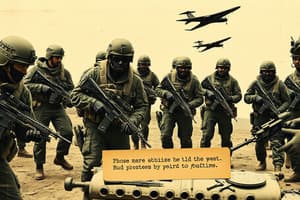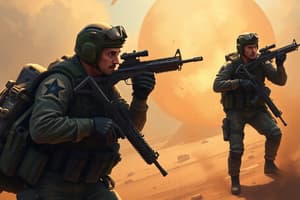Podcast
Questions and Answers
What did Bob Hoffman do to promote physical fitness?
What did Bob Hoffman do to promote physical fitness?
- Founded the York Barbell Company
- Emphasized the importance of physical activity for combat readiness in his book
- All of the above (correct)
- Started Muscle Development magazine
What physical training methods did Jocko Willink's Navy team experiment with?
What physical training methods did Jocko Willink's Navy team experiment with?
- All of the above (correct)
- Bodybuilding
- Calisthenics
- Triathlons
What inspired Dave Castro's approach to physical training?
What inspired Dave Castro's approach to physical training?
- None of the above
- Mark Twight's book 'Extreme Alpinism' (correct)
- Jocko Willink's book 'Extreme Ownership'
- Bob Hoffman's book 'How to be Strong, Healthy, and Happy'
What did Mark Twight introduce Dave Castro to?
What did Mark Twight introduce Dave Castro to?
What does CrossFit combine to train individuals?
What does CrossFit combine to train individuals?
What does the author believe is more important than physical fitness for BUD/S?
What does the author believe is more important than physical fitness for BUD/S?
What does one of the former Navy SEALs believe is the key to transitioning out of the military?
What does one of the former Navy SEALs believe is the key to transitioning out of the military?
What did the author do to prepare for BUD/S?
What did the author do to prepare for BUD/S?
Flashcards are hidden until you start studying
Study Notes
The Evolution of Physical Training for Combat Readiness
-
Bob Hoffman's book "I Remember the Last World War" emphasizes the importance of physical activity for combat readiness.
-
Hoffman's other book "How to be Strong, Healthy, and Happy" promotes physical training to overcome obstacles and build confidence.
-
Hoffman founded the York Barbell Company and started Muscle Development magazine to spread the word about physical fitness.
-
Jocko Willink's Navy team experimented with various physical training methods, including calisthenics, triathlons, bodybuilding, Olympic lifting, powerlifting, and gymnastics.
-
Dave Castro, a SEAL who deployed to Iraq and Afghanistan, also sought the best way to get fit for combat, leading him to CrossFit.
-
Prior to CrossFit, physical training methods were often done in isolation, such as running, bodyweight exercises, or Olympic lifting.
-
Mark Twight, a famous climber, inspired Castro's approach to physical training through his book "Extreme Alpinism," which advocated for super light and fast climbs.
-
Twight later introduced Castro to CrossFit, which at first he was skeptical of due to not growing up with Olympic lifts or powerlifting.
-
Castro researched CrossFit while on deployment and eventually became a believer in its effectiveness.
-
CrossFit combines various elements of fitness, including bodyweight movements, running, cleans, deadlifts, and pull-ups.
-
CrossFit has been used to train SEALs, Special Operations personnel, conventional soldiers, Marines, law enforcement, first responders, and everyday civilians.
-
Physical fitness remains an important aspect of combat readiness, and various methods have been explored to find the most effective approach.From CrossFit to Navy SEAL: A Journey of Perseverance
-
The narrator was introduced to CrossFit by a fellow Navy SEAL during a deployment to Iraq.
-
The narrator was initially hesitant to try CrossFit, but eventually fell in love with it and saw great results.
-
The narrator's interest in becoming a Navy SEAL was sparked by watching the movie "The Rock" and researching the Navy SEALs online.
-
The narrator followed the BUD/S warning order, an online training protocol for BUD/S preparation, before enlisting in the Navy.
-
The narrator found boot camp to be a cultural shock, particularly in regards to unfamiliar foods like grits.
-
The narrator's Mexican heritage did not give him an advantage in the military, as performance and meeting standards were the most important factors.
-
The narrator's strength during BUD/S was being a middle-of-the-road performer, while his weakness was swimming.
-
The narrator swam extensively to prepare for BUD/S, but still struggled with general comfort in the water.
-
The narrator's mindset of focusing on making it to the next meal helped him persevere through the grueling BUD/S training.
-
The narrator's journey from CrossFit to Navy SEAL demonstrates the importance of chasing one's dreams and being realistic and measured in the pursuit.
-
The narrator emphasizes the mental toughness required for BUD/S, rather than just physical fitness.
-
The narrator's journey led him to become a Navy SEAL and eventually a successful entrepreneur, with a deep appreciation for the CrossFit Ranch where the CrossFit Games are held.A Navy SEAL's Experience in BUD/S and Beyond
-
The author attended BUD/S at the age of 18/19 and was paired with a 32-year-old Force Recon gunnery sergeant as a roommate.
-
The author tried to avoid drawing too much attention from instructors and classmates and focused on getting the job done.
-
The author graduated from BUD/S without getting performance rolled or injured.
-
The author did not win any runs or obstacle courses but was a good swimmer.
-
The author does not like to talk about which SEAL team he was on or his rank, as he does not want his identity to be solely defined by his SEAL experience.
-
The author believes that the movie "Act of Valor" sent the wrong message to the SEAL community by using SEALs' likeness to profit and recruit without compensating them.
-
The author has read Jocko Willink's book "Extreme Ownership" and appreciates the message of sharing important lessons learned.
-
The author has been busier since retiring from the Navy than when he was serving.
-
The author does not want to become defined solely by his SEAL experience and wants to focus on what he has done since then.
-
The author respects other SEALs who choose to talk about their experiences publicly but has chosen a different path for himself.
-
The author believes that there are SEALs who are over the top with how they talk about their experiences publicly.
-
The author wants to set an example for younger SEALs that they can transition out of the Navy and do something else without leaning too much on their SEAL experience.A conversation between two former Navy SEALs about their experiences and transitions
-
The conversation is between two former Navy SEALs discussing their experiences and transitions after leaving the service.
-
One of the SEALs had a unique transition experience as he worked for CrossFit and had permission to do so while also being a full-time Navy instructor.
-
Both SEALs acknowledge that transition advice may not be applicable to everyone as each individual's situation is unique.
-
The conversation also touches on the saturation of military stories in the market and the importance of having a compelling message to share.
-
One of the SEALs enlisted in the Navy during peacetime, while the other enlisted just after 9/11 when the chances of going to war were higher.
-
The SEALs talk about their experiences as new guys in a SEAL platoon and how it was a formative and influential time for them.
-
One of the SEALs served as a radio man and was advised to do so if he wanted to go on every mission.
-
The conversation then shifts to the events of 9/11, where one of the SEALs remembers seeing Osama Bin Laden's name on the FBI's top 10 list just a few days before the attacks.
-
The SEALs discuss how it took longer than expected for them to go from peacetime deployments to wartime deployments.
-
One of the SEALs recalls his experience of being in Iraq in 2003 and having only one platoon there, while in 2006, his whole team was deployed to Iraq.
-
The conversation ends with one of the SEALs talking about his book on the Battle of Ramadi in 2006 and how it was a difficult time for their team.
-
Both SEALs acknowledge the difficulty of transitioning out of the military and finding a new purpose but also the importance of having a supportive community.
Studying That Suits You
Use AI to generate personalized quizzes and flashcards to suit your learning preferences.




